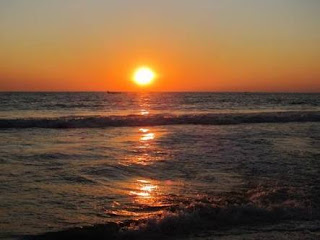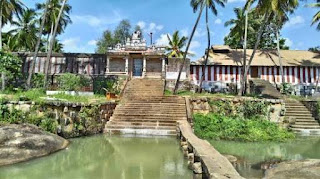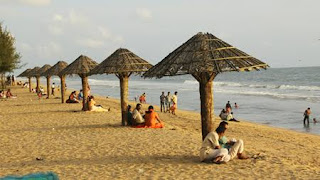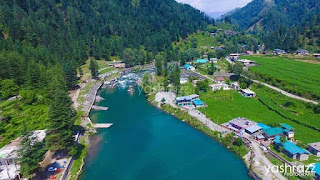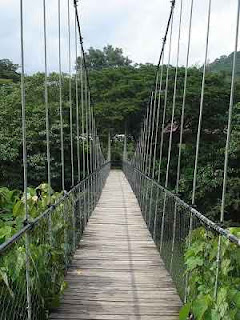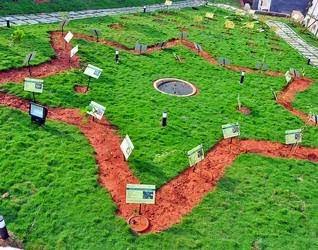The Kerala-Tamil Nadu border is blessed with waterfalls and among them, Kutralam is probably the best one. Even though Thirparappu (not exactly at the border yet close to it) has the highest number of visitors, Kutralam is equally popular and scenic. Considered as South India's own Spa, the rich natural water is what you need in a pleasant tiring summer. At a distance of 7 km from Tenkasi, 160 km from Madurai, 62 km from Tirunelveli & 625 km from Chennai, Courtallam, or Kutralam is well known for Courtallam Falls which is one of the most famous waterfalls in Tamilnadu.
One of the main reason why I visited Kutralam with my family was the Kutralanathar temple, which is at a walkable distance from the main falls. The reason why I said, "main falls" is that Kutralam has smaller falls surrounding it. We reached the place at about 7 AM and without wasting much time we got into the falls so that we could freshen up before entering the pilgrimage. We were fortunate to find a bus that took us straight to Kutralam stand which is about a few metres away from the temple. Buses can be found easily from the Tenkasi stand which is about 10 km from Kutralam.
Kutralam waterfalls is located at an elevation of about 550 feet in the Western Ghats. The water here passes over a lot of medicinal herbs and therefore has the capacity to cure a number of ailments. After a quite a lot of research and conversations with locals, I came to know that the one near the bus stand is the biggest fall and is called Peraruvi. The place was packed and it took me half hour to get my turn to enter the place. The place is well maintained and the entire place is cool and perfect for summer. The chances of finding an abundant flow on summers is slim yet, you can still find enough water for you to soak yourself.
Thirukutralanathar temple is one among the auspicious temples in Tamil Nadu and visitors around India gather here to attain blessings. The sage Agastyar, at Shiva's request, proceeded southward to stabilize the balance of the earth and relieve the instability caused by the multitude of entities at Shiva's and Parvati's wedding in the Himalayas, to wait for a glimpse of the divine couple. There he is said to have created the Shivalingam here by shrinking an image of Vishnu, hence the name Kutralam. In the shrine, Shiva showed himself as Bhrama and Vishnu. The presiding deity Lord Shiva is called as Kuttralanathar and the Ambal his consort mother Parvathy is called as Kuzhalvoi Mozhiammai.
Kutralam is one among the MUST-SEE places in India that will leave you wanting more. Once you are there, make sure to cover all the other falls as well. Even though the fall might seem small but the place is beautiful and the ambience is pretty neat. Also, it is ideal to plan visits between June and September, as monsoon is the best time to get some consistent flow off the falls.
Contributed by Sooraj Ram
One of the main reason why I visited Kutralam with my family was the Kutralanathar temple, which is at a walkable distance from the main falls. The reason why I said, "main falls" is that Kutralam has smaller falls surrounding it. We reached the place at about 7 AM and without wasting much time we got into the falls so that we could freshen up before entering the pilgrimage. We were fortunate to find a bus that took us straight to Kutralam stand which is about a few metres away from the temple. Buses can be found easily from the Tenkasi stand which is about 10 km from Kutralam.
Kutralam waterfalls is located at an elevation of about 550 feet in the Western Ghats. The water here passes over a lot of medicinal herbs and therefore has the capacity to cure a number of ailments. After a quite a lot of research and conversations with locals, I came to know that the one near the bus stand is the biggest fall and is called Peraruvi. The place was packed and it took me half hour to get my turn to enter the place. The place is well maintained and the entire place is cool and perfect for summer. The chances of finding an abundant flow on summers is slim yet, you can still find enough water for you to soak yourself.
Thirukutralanathar temple is one among the auspicious temples in Tamil Nadu and visitors around India gather here to attain blessings. The sage Agastyar, at Shiva's request, proceeded southward to stabilize the balance of the earth and relieve the instability caused by the multitude of entities at Shiva's and Parvati's wedding in the Himalayas, to wait for a glimpse of the divine couple. There he is said to have created the Shivalingam here by shrinking an image of Vishnu, hence the name Kutralam. In the shrine, Shiva showed himself as Bhrama and Vishnu. The presiding deity Lord Shiva is called as Kuttralanathar and the Ambal his consort mother Parvathy is called as Kuzhalvoi Mozhiammai.
Kutralam is one among the MUST-SEE places in India that will leave you wanting more. Once you are there, make sure to cover all the other falls as well. Even though the fall might seem small but the place is beautiful and the ambience is pretty neat. Also, it is ideal to plan visits between June and September, as monsoon is the best time to get some consistent flow off the falls.
Contributed by Sooraj Ram















